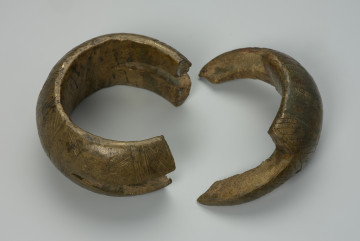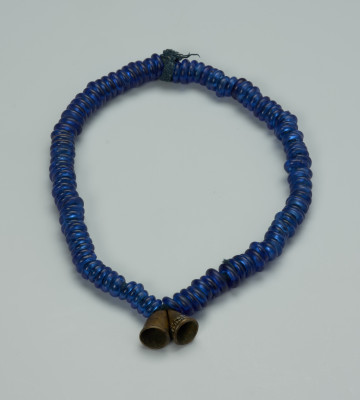
Women's anklet
między 1940 — 1950
National Museum in Szczecin
Part of the collection: Collection of Dogonian art
The women's bracelet was cast from copper using the lost wax method by a Dogon blacksmith. It is an ornament rarely seen nowadays. In the past, this type of bracelets was worn by women on the wrists of both hands. Nowadays, light and delicate decorations prevail. Large and heavy bracelets have practically fallen out of use. In Dogon society, two occupational groups play a crucial role - blacksmiths and leatherworkers. They are regarded as people from castes - closed social groups, accessible only by birth. Blacksmiths, called iru in the Dogoso language, are considered specialists in metalworking (they make objects of iron, copper, bronze, brass and aluminium) and 'masters of wood'. Thanks to their profession, they are highly respected by the Dogon. Blacksmithing is considered the most durable craft, which requires a high level of specialisation and skill. The figure of the blacksmith also occupies a special place in Dogon mythology. According to the myth, the blacksmith came down to earth from heaven and brought the first people cereal grains and daba, iron hoes, that made them farmers. Besides, he stole a piece of the sun to light the first fire to make the necessary tools and weapons for the people. The Dogon believe that modern blacksmiths are the descendants of the mythical protoplast, who taught the people farming and popularised tools. The blacksmith also acts as a mediator in disputes. During quarrels, he strikes stones with a hammer to calm tempers and bring order. Moreover, he is regarded as a link between the human world and the world of supernatural forces. People turn to him for help when they offend their ancestors with their behaviour. He is also asked to make sculptures and objects that, endowed with the power of the ancestors, are supposed to bring them health, prosperity, fertility, fertility of the earth and harvest.
Katarzyna Findlik-Gawron
Author / creator
Dimensions
cały obiekt: height: 2,7 cm, width: 9,6 cm
Object type
body adornment, jewellery
Creation time / dating
Creation / finding place
Identification number
Location / status

między 1940 — 1950
National Museum in Szczecin

między 1920 — 1930
National Museum in Szczecin

między 1920 — 1930
National Museum in Szczecin
DISCOVER this TOPIC
National Museum in Lublin
DISCOVER this PATH
Educational path